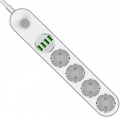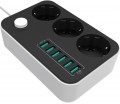Cable length
The length of the cable used to connect the surge protector to the network.
The longer the cable, the farther from the outlet you can install the device. On the other hand, a long cable can be inconvenient over short distances. Models on a coil are deprived of this drawback (see "Type"), this moment is compensated by the actual presence of the coil, but they differ in large dimensions and heavy weight. So when choosing, it is far from always worth chasing the maximum length of the wire.
Grounded sockets (type F)
The number of
sockets with type F grounding, provided in the design of the mains filter.
In this case, we are talking about full-size European type F sockets with metal ground clamps on both sides at the edges of the socket. The "socket" in this case means a CEE 7/4 ("Schuko") standard plug. Grounding is required for the safe operation of some types of electrical appliances, in particular, washing machines and other machines that work with water, refrigerators, computers, audio equipment, etc. A detailed list can be found in the reference literature. If you plan to connect such devices through the filter, this filter must have sockets with grounding.
USB A
The number of
USB ports for charging, provided in the design of the surge protector.
Such ports do not perform any other function than powering and charging external devices such as smartphones or tablets. The presence of such connectors in the surge protector can be especially convenient when there is no “230-to-USB” adapter at hand, and there are few USB ports in a computer or laptop and using them for charging is “an unaffordable luxury”.
Charge current
Current value for all USB ports of the device. Allows you to understand how much maximum you can squeeze out of the device, i.e. how much current will be supplied to each port at maximum load. As for the maximum value of the current strength, it cannot be determined by this indicator.

